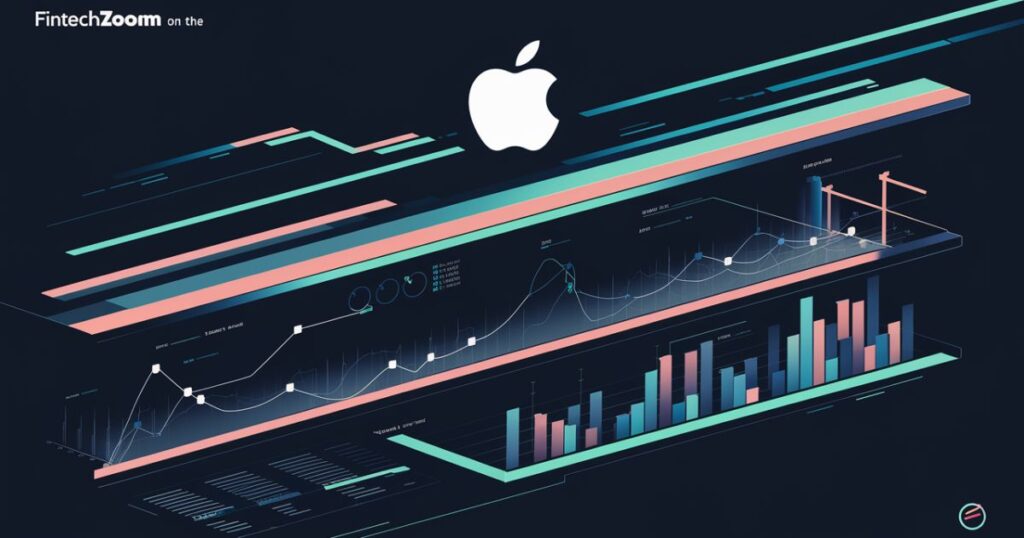As one of the world’s most valuable companies, Apple has captured the imagination of investors across the globe. The tech giant’s stock, often referred to as AAPL, is widely traded and closely watched by market participants.
In this comprehensive guide, we’ll dive deep into the world of Apple stock on FintechZoom, a leading financial analysis platform. Whether you’re a seasoned investor or just starting, this insider’s look will equip you with the tools and knowledge to navigate AAPL’s trading landscape like a pro.
Why Apple’s Stock Matters to the US Market
Apple’s influence on the US stock market cannot be overstated. As a multinational technology behemoth, its stock performance is often seen as a barometer for the overall health of the economy. Legendary investor Warren Buffett once described Apple’s stock as a powerful economic “tape” to read.
Just like how dropping a pebble creates ripples across a pond, Apple’s stock movements can send shockwaves through major market indices like the Dow Jones Industrial Average and the S&P 500. Its sheer size and brand recognition make AAPL a bellwether for investor sentiment and consumer spending trends.
Read More: INSTASUPERSAVE.COM: THE ULTIMATE INSTAGRAM PHOTO AND VIDEO DOWNLOADER FOR USA USERS
Decoding Apple stock on FintechZoom Symbols and Terminology
Before we dive deeper, let’s demystify some of the jargon surrounding stocks on FintechZoom:
Ticker Symbol: A unique series of letters assigned to publicly traded companies for easy identification (e.g., AAPL for Apple Inc.).
Share Price: The current trading value of one share of a company’s stock.
Market Capitalization: The total dollar value of a company’s outstanding shares, calculated by multiplying the share price by the number of shares.
Volume: The number of shares traded over a specific period, indicating liquidity and investor interest.
On FintechZoom, you’ll find Apple’s ticker symbol prominently displayed alongside up-to-the-second share pricing, market cap, volume data, and more. Understanding this fundamental information is key to making informed investment decisions.
Tools to Analyze Apple Stock’s Real-Time Data
FintechZoom offers a veritable arsenal of powerful tools to help you analyze AAPL’s performance from every angle. Think of these as your weapons in the battle for investment insights:
- Interactive Charts: Visualize AAPL’s historical price movements, trading volume, and technical indicators through customizable, interactive charts.
- Stock Screeners: Filter through thousands of stocks based on specific criteria like market cap, sector, performance metrics, and more to find potential investment opportunities alongside AAPL.
- Financial Statement Analysis: Dig into Apple’s quarterly and annual reports, including income statements, balance sheets, and cash flow statements, to evaluate the company’s financial health.
- Analyst Ratings: Access professional analysts’ buy, sell, or hold recommendations on AAPL, along with their price targets and analysis rationale.
- News Aggregation: Stay on top of the latest headlines, press releases, and market-moving events that could impact AAPL’s price action.
With these powerful tools at your fingertips, you’ll have a 360-degree view of Apple’s stock, empowering you to make data-driven investment decisions.
Factors That Influence Apple’s Stock Price
Like any publicly-traded company, Apple’s stock price is subject to a myriad of internal and external factors that can cause significant fluctuations. Here are some of the major forces that can move AAPL’s needle:
- Product News and Launches: As a consumer technology company, Apple’s stock is highly sensitive to the success (or failure) of new product releases like iPhones, iPads, and Macs. Positive reception and strong sales can drive the share price higher, while product missteps or supply chain issues can spell trouble.
- Earnings Reports: Every quarter, Apple reports its financial results, including revenue, profits, and guidance for the upcoming period. These reports can significantly impact investor sentiment and AAPL’s stock price, depending on whether the company meets, exceeds, or misses Wall Street’s expectations.
- Competition: While Apple enjoys a loyal customer base, it faces stiff competition from rivals like Samsung, Google, and Microsoft. Innovative new products or aggressive pricing strategies from competitors can put pressure on Apple’s market share and profitability, weighing on its stock performance.
- Global Economic Conditions: As a multinational company, Apple’s fortunes are tied to the overall health of the global economy. Factors like GDP growth, consumer spending, trade tensions, and currency fluctuations can all impact AAPL’s stock price.
- Regulatory Environment: Apple operates in a highly regulated industry, subject to rules and policies around data privacy, anti-trust laws, and intellectual property rights. Changes in these regulations can significantly impact the company’s business model and future growth prospects, influencing investor sentiment towards AAPL.
- Consumer Demand Trends: Apple’s success is heavily dependent on consumer demand for its products. Shifts in consumer preferences, spending habits, and technological trends can significantly impact the company’s sales and, consequently, its stock price.
To illustrate the impact of these factors, consider the following example: In November 2018, Apple’s stock plunged nearly 7% in a single day after the company warned of slowing iPhone sales and lowered its revenue guidance for the holiday quarter, citing economic headwinds in emerging markets like China.
Comparing Apple to Other Big Tech Stocks
While Apple is a tech titan in its own right, it’s often compared to other industry heavyweights like Microsoft, Amazon, Alphabet (Google’s parent company), and Facebook – collectively known as the “FANG” stocks. Here’s a quick snapshot of how AAPL stacks up against its FANG peers:
| Metric | Apple | Microsoft | Amazon | Alphabet | |
|---|---|---|---|---|---|
| Market Cap | $2.9T | $2.3T | $1.7T | $1.6T | $629B |
| P/E Ratio | 31.2 | 36.5 | 65.8 | 25.7 | 22.8 |
| Revenue Growth (YoY) | 8.1% | 18.4% | 27.6% | 23.5% | 37.4% |
| Net Profit Margin | 25.7% | 38.5% | 7.1% | 29.6% | 33.4% |
Data as of May 2024
While Apple boasts an impressive market capitalization and profit margins, its growth rates have slowed compared to some of its FANG counterparts. This has led to ongoing debates about whether AAPL should still be considered a growth stock or a more mature, value-oriented investment.
Strategic Approaches for Trading AAPL on FintechZoom
Traders and investors approach the markets with a variety of strategies, each with its own risks and potential rewards. Here are some common approaches used when trading AAPL on FintechZoom:
- Value Investing: Value investors seek stocks that are trading below their perceived intrinsic value, based on fundamental analysis of the company’s financials, assets, and growth prospects. For Apple, value investors might see the stock as undervalued during periods of market overreaction or cyclical downturns.
- Growth Investing: Growth investors prioritize companies with strong revenue and earnings growth potential, often paying a premium for these stocks. Apple’s history of innovation and dominant market position in consumer electronics have made it a popular growth stock, though some investors question its future growth trajectory.
- Technical Analysis: Technical traders rely on chart patterns, price movements, and various technical indicators to identify potential entry and exit points for trades, without much regard for the underlying company fundamentals. AAPL’s high liquidity and volatility make it a popular target for technical analysis strategies.
- Income Investing: While not known for its dividend yield, Apple has consistently returned cash to shareholders through share buybacks and dividend payments. Income investors may consider AAPL as part of a diversified dividend-paying portfolio.
No single approach is inherently “better” than the others – each carries its own set of risks and potential rewards. For example, a value investor who bought AAPL in the early 2000s when it was trading at a fraction of its current price would have reaped enormous gains. However, a technical trader who tried to catch AAPL’s steep sell-off in 2018 may have suffered significant losses if their timing was off.
Brokers and Platforms for US Investors to Trade AAPL
Note: There seems to be a formatting issue with the table in the previous response, so I’ll try to recreate the table here:
| Metric | Apple | Microsoft | Amazon | Alphabet | |
|---|---|---|---|---|---|
| Market Cap | $2.9T | $2.3T | $1.7T | $1.6T | $629B |
| P/E Ratio | 31.2 | 36.5 | 65.8 | 25.7 | 22.8 |
| Revenue Growth (YoY) | 8.1% | 18.4% | 27.6% | 23.5% | 37.4% |
| Net Profit Margin | 25.7% | 38.5% | 7.1% | 29.6% | 33.4% |
Data as of May 2024
Brokers and Platforms for US Investors to Trade AAPL
With the rise of online trading platforms, it’s never been easier for US investors to buy and sell shares of AAPL and other stocks. Here’s a quick overview of some of the most popular brokers and platforms for trading Apple stock on FintechZoom:
- Fidelity: One of the largest and most well-established brokers, Fidelity offers a user-friendly trading platform, extensive research tools, and a wide range of account types for individual investors and institutional clients alike.
- TD Ameritrade: Known for its powerful thinkorswim trading platform, TD Ameritrade is a favorite among active traders and investors. It offers comprehensive charting tools, virtual trading simulations, and a vast educational resource library.
- E*Trade: E*Trade’s intuitive web and mobile platforms make it a popular choice for beginner and casual investors. Its platform offers real-time streaming quotes, analyst research, and a variety of account options, including retirement accounts.
- Charles Schwab: With a strong focus on investor education and customer service, Charles Schwab is a solid choice for traders of all experience levels. Its StreetSmart Edge platform provides advanced trading tools and extensive market data.
- Robinhood: Aimed at younger, tech-savvy investors, Robinhood offers commission-free trading on a sleek mobile app. While its research and analysis tools are more limited, its easy-to-use interface has made it a hit with millennials.
When choosing a broker or platform, consider factors like trading fees, account minimums, research and analysis tools, mobile accessibility, and overall user experience. Many platforms offer virtual trading simulations or paper trading accounts, which can be a great way to practice trading AAPL risk-free.
FAQs About Investing in Apple Stock for US Traders
Even with all the information and tools at your disposal, investing in Apple stock on FintechZoom can still raise a lot of questions. Here are some frequently asked questions (and answers!) from US traders:
Is Apple’s stock a good long-term investment?
Like any investment, there are no guarantees – but Apple’s strong brand recognition, loyal customer base, and consistent profitability make it a compelling long-term holding for many investors. However, its slowing growth rates and increasing competition mean investors should thoroughly research and monitor the company’s performance and future prospects.
What’s the best online broker for trading AAPL?
There’s no one-size-fits-all answer, as the “best” broker depends on your individual trading style, experience level, and preferences. That said, major players like Fidelity, TD Ameritrade, and E*Trade offer robust trading platforms, research tools, and educational resources well-suited for AAPL traders.
How volatile is Apple’s stock price?
While not as volatile as some high-growth tech stocks, AAPL’s share price can still experience significant swings due to its size and influence. Its beta value (a measure of volatility relative to the overall market) is around 1.2, meaning it’s moderately more volatile than the broader market. Investors should be prepared for potential ups and downs, especially around major events like product launches and earnings reports.
Can I trade AAPL options on FintechZoom?
Absolutely! FintechZoom’s platform supports options trading on AAPL and other major stocks. Options can provide leverage and hedging opportunities but also carry higher risk. Proper education and risk management are essential for successful options trading.
Conclusion
In this comprehensive guide, we’ve explored the ins and outs of trading Apple’s stock (AAPL) on the powerful Apple stock on FintechZoom platform. From dissecting the factors that influence its share price to evaluating different investment strategies and brokers, we’ve aimed to provide you with a 360-degree view of this widely-traded tech titan.
But investing, at its core, is a journey of continuous learning and adaptation. As markets evolve and new trends emerge, it’s crucial to stay informed, conduct thorough research, and refine your strategies accordingly. FintechZoom’s suite of analysis tools, real-time data, and expert insights can be invaluable allies in this pursuit.







